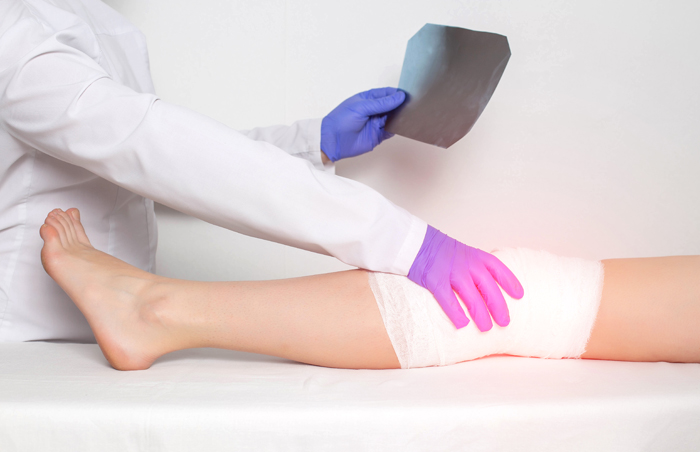Tendon and Ligament Repair
Introduction
Tendons are fibrous connective tissues that link muscles to bones. They also connect muscles to other structures, such as the eyeball. Another function of a tendon is to move the bone or structure. A ligament tear is a fibrous connective tissue that connects bones and serves to hold things together and stabilize them. Ligament tears are common as a result of sports injuries.
The Achilles tendon, which connects the calf muscles to the heel, can sustain high levels of stress from running and jumping and is susceptible to damage. A tendon rupture occurs when the fibers of the tendon break and separate, preventing the tendon from performing its usual functions. An Achilles tendon repair can be non-surgical or surgical. A surgeon makes one or more tiny incisions (cuts) in the skin around the injured tendon or stitches the torn ends of the tendon together.
Ankle ligament reconstruction is a procedure that involves tightening and firming one or more ankle ligaments on the outside of the ankle. Brostrom technique is another name for it. If one or more of the ligaments on the outside of your ankle have loosened or strained, you may need ankle ligament reconstruction surgery.

Types of Ligament and Tendon Reconstructions
Ligament and tendon reconstructions come in a variety of shapes and sizes. The following are some examples:
- Direct primary repair
- Primary surgery
- Other operations that might be carried out
In addition to ligament and tendon restoration, your doctor may undertake other operations. Some of these are:
- A bone spur removal
- Osteotomy
- Symptoms
Depending on whatever ligament is damaged, the symptoms will differ. The most common symptom is pain. The joint or tendon might be uncomfortable, and get worse at night or while you are moving around. A tendon injury caused by wear, tear, or trauma generally results in localized discomfort rather than pain that spreads over several joints.
Causes
Tendon injuries can occur even if there is no evidence of overuse. Rheumatoid arthritis, for example, can occasionally induce inflammation of tendon sheaths as well as joints. This results in additional symptoms such as joint pain and swelling, as well as tendon damage symptoms.
Ligament injuries are more common in activities such as skiing, basketball, and soccer.
When Should You See a Doctor?
Tendinitis can go away on its own in certain circumstances. However, if the signs and symptoms persist for more than 48 hours, and the discomfort does not go away or interferes with your lifestyle and regular activities, you should see a doctor right away.
Risk Factors
Tendon repair carries the following risks:
- Scar tissue can grow and obstruct the smooth movement of the joints.
- Reduction in combined usage
- Joint's rigidity
- Re-tear in the tendon
Anesthesia risks include adverse drug reactions such as difficulty in breathing, redness, or itching. Surgical risks include bleeding and infection in general.
Request an appointment at Apollo Spectra Hospitals.
Call 1860-500-2244 to book an appointment
Possible Complications
If you work with a board-certified hand surgeon with experience in microsurgery and plastic surgery, you will have a lower risk of triggering finger surgery complications. During surgery, the doctors will move and test your finger.
Prevention
Some preventive actions include:
- Avoid activities that put excessive strain on the tendons, especially for lengthy periods.
- Combine high-impact activities such as running with low-impact activities such as bicycling or swimming.
- Work on your technique.
- Stretch.
- Use good ergonomics in the workplace.
Remedies or Treatment
Your doctor may prescribe pain painkillers, corticosteroids, or platelet-rich plasma to treat tendinitis (PRP).
You may require a schedule of targeted exercises to stretch and strengthen the damaged muscle-tendon unit.
To treat tendon and ligament injuries at home, remember the phrase R.I.C.E. (rest, ice, compression, and elevation). This therapy can aid in your rehabilitation and help you avoid subsequent issues.
Conclusion
Tendinitis, like other injuries, can heal on its own if caught early enough. However, if it persists and does not go away on its own, see a doctor and get yourself treated. It is critical to keep an eye on the injury. If untreated, it can progress to chronic issues that might cause future difficulties and even immobility. As usual, prevention is preferable to cure.
Yes, tendinitis can cause pain, swelling, soreness, and, in rare cases, immobilization of the damaged region.
The inflammation and soreness can go away on their own if taken care of using treatment solutions such as compression, cold packs, and elevation. However, if the injury lasts longer than expected, it is better to keep an eye on it and visit a doctor.
Yes, this injury is treatable.
Our Doctors
DR. ANKUR SINGH
MBBS, D.Ortho, DNB -...
| Experience | : | 11 Years Experience |
|---|---|---|
| Speciality | : | Orthopaedics and Tra... | Location | : | NSG Chowk |
| Timings | : | Mon - Sat : 10:00 A... |
NOTICE BOARD
CONTACT US
CONTACT US
 Book Appointment
Book Appointment



.svg)
.svg)
.svg)
.svg)








